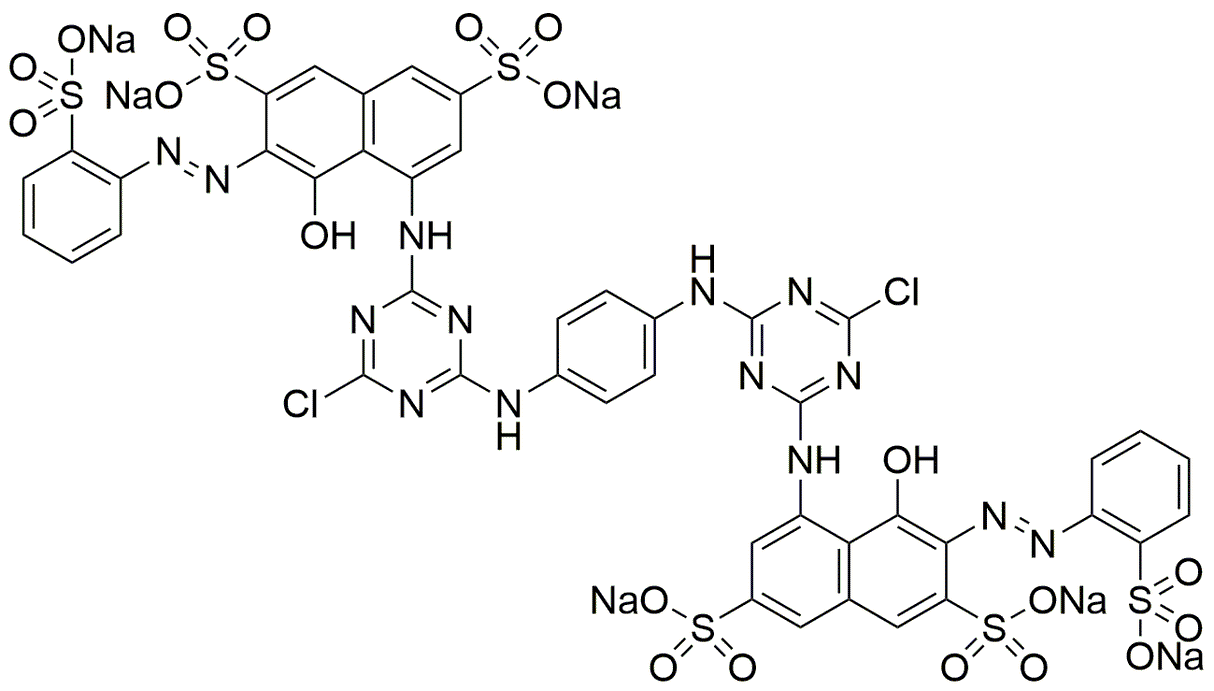Reactive Red 120 is widely utilized in research focused on:
- Dyeing Textiles: This compound is extensively used in the textile industry for dyeing fabrics, particularly cotton and polyester. Its vibrant color and excellent lightfastness make it a popular choice for producing high-quality dyed materials.
- Biological Staining: In biological research, it serves as a staining agent for microscopy. It helps visualize cellular structures, making it easier for researchers to study tissue samples and cellular components.
- Environmental Monitoring: Reactive Red 120 is employed in environmental studies to track water pollution. Its presence in water bodies can indicate contamination, helping researchers assess the health of aquatic ecosystems.
- Food Industry Applications: This chemical is sometimes used as a food colorant, providing a visually appealing hue to various food products. Its stability under different conditions makes it suitable for use in processed foods.
- Research in Chemical Synthesis: It is also utilized in synthetic chemistry as a reagent for developing new compounds. Its unique chemical properties allow researchers to explore new reactions and create innovative materials.
General Information
Properties
Safety and Regulations
Applications
Reactive Red 120 is widely utilized in research focused on:
- Dyeing Textiles: This compound is extensively used in the textile industry for dyeing fabrics, particularly cotton and polyester. Its vibrant color and excellent lightfastness make it a popular choice for producing high-quality dyed materials.
- Biological Staining: In biological research, it serves as a staining agent for microscopy. It helps visualize cellular structures, making it easier for researchers to study tissue samples and cellular components.
- Environmental Monitoring: Reactive Red 120 is employed in environmental studies to track water pollution. Its presence in water bodies can indicate contamination, helping researchers assess the health of aquatic ecosystems.
- Food Industry Applications: This chemical is sometimes used as a food colorant, providing a visually appealing hue to various food products. Its stability under different conditions makes it suitable for use in processed foods.
- Research in Chemical Synthesis: It is also utilized in synthetic chemistry as a reagent for developing new compounds. Its unique chemical properties allow researchers to explore new reactions and create innovative materials.
Documents
Safety Data Sheets (SDS)
The SDS provides comprehensive safety information on handling, storage, and disposal of the product.
Product Specification (PS)
The PS provides a comprehensive breakdown of the product’s properties, including chemical composition, physical state, purity, and storage requirements. It also details acceptable quality ranges and the product's intended applications.
Certificates of Analysis (COA)
Search for Certificates of Analysis (COA) by entering the products Lot Number. Lot and Batch Numbers can be found on a product’s label following the words ‘Lot’ or ‘Batch’.
*Catalog Number
*Lot Number
Certificates Of Origin (COO)
This COO confirms the country where the product was manufactured, and also details the materials and components used in it and whether it is derived from natural, synthetic, or other specific sources. This certificate may be required for customs, trade, and regulatory compliance.
*Catalog Number
*Lot Number
Safety Data Sheets (SDS)
The SDS provides comprehensive safety information on handling, storage, and disposal of the product.
DownloadProduct Specification (PS)
The PS provides a comprehensive breakdown of the product’s properties, including chemical composition, physical state, purity, and storage requirements. It also details acceptable quality ranges and the product's intended applications.
DownloadCertificates of Analysis (COA)
Search for Certificates of Analysis (COA) by entering the products Lot Number. Lot and Batch Numbers can be found on a product’s label following the words ‘Lot’ or ‘Batch’.
*Catalog Number
*Lot Number
Certificates Of Origin (COO)
This COO confirms the country where the product was manufactured, and also details the materials and components used in it and whether it is derived from natural, synthetic, or other specific sources. This certificate may be required for customs, trade, and regulatory compliance.


